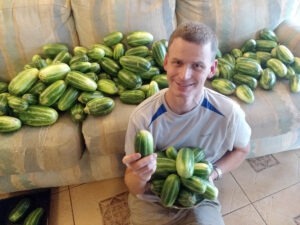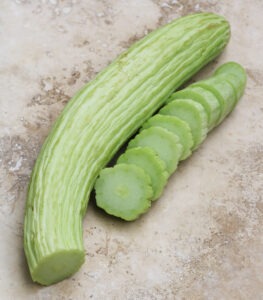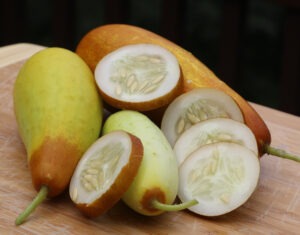To celebrate Seed Savers Exchange's 50th anniversary, we are featuring the work and inspiration of Exchange listers in the "Hope and Practice" series.
Hope and Practice: Jay Tracy

‘Cultivate varieties that thrive in your climate and that you can (and want) to maintain.’
Jay Tracy, Exchange lister, reflects on the importance of saving and sharing heirloom varieties—especially cucumbers.
I began saving seed in 2008 in my first garden in Tucson, Arizona. While gardening there, I discovered the snake melon and carosello cucumbers as well as many other muskmelons that, for millennia, have been cultivated as delicious cucumbers. In addition to growing dozens of types of these cucumber-melons, I have developed lasting friendships with fellow gardeners in various countries—including Italy, India, and Indonesia—over the years.
Generations of growers who saved seed before them enabled my gardening friends to entrust their cherished heritage seed with me to steward and then share with others. Though I have since moved to California, I love to grow and share these cucumber-melons because of their fine, tender, yet crisp, texture; their bitter-free, complex flavor; their ease of digestion; and their diversity of shapes, sizes, and colors. My current favorites are the Italian cultivars ‘Meloncella Fasciata di Salento’ and ‘Minuncedda di Sternatia,’ both carosello cucumbers. [Note: The carosello is a landrace variety of melon (Cucumis melo) from Southern Italy.]

I initially contacted Seed Savers Exchange in 2019 or 2020 hoping that I would find a repository for some incredibly rare indigenous cucumber-melon seed. After learning that SSE was primarily interested in heirlooms with a story from the United States, I eventually decided to offer a few of the extremely rare varieties that I saved the previous year to individuals through the Exchange, and I have been doing that for the last couple years.
With the exception of one Italian friend with whom I share everything, a few of the varieties that I steward are found nowhere else. I was fortunate to have individuals share these varieties with me or to happen upon them—but I have been doing a great deal of caretaking on my own. Given that many of these varieties were being grown long before historical records were kept, it would be a comfort to know that, if anything were to happen to me, they would not be lost.
I encourage other gardeners and seed savers to cultivate varieties that thrive in their climate and that they can (and want) to maintain, both for this generation and into the future. The varieties that are both resilient in your climate and highly marketable will most likely be the ones that are passed on to future generations.
Jay Tracy of Fairfield, California, has dedicated himself to growing open-pollinated cucumbers and cucumber-melons from around the world for over a decade. In August 2024, he presented “Confronting Climate Concerns with Indigenous Heritage Cucurbit Varieties” at SSE’s annual virtual conference. The owner of the hobby business Cucumber Shop, Jay lists four varieties of cucumber-melons in the 2025 Yearbook.
Try these unique cukes!

This cucumber-melon’s crunchy flesh is burpless, never bitter, and perfect for making pickles.

Delicious, smooth-skinned fruits turn from white to golden-yellow to russet- brown and may be eaten at any stage, skin and all.